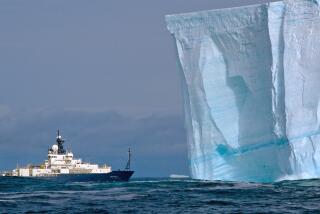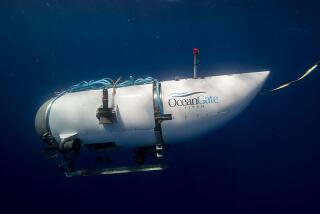A Teacher-Explorer Savors Life as a Never-Ending Series of Challenges
- Share via
Though explorer Ann Bancroft has traversed the ice to the North and South poles, her most difficult challenges didn’t take place in the frigid wilderness.
She overcame a learning disability to achieve a lifelong goal of becoming a teacher. Years later, she also quickly developed business skills so she could raise money for her expeditions.
Those, she said, proved to be greater challenges than towing a 250-pound sled across wild Antarctica in minus-30-degree weather.
“For me, the greatest obstacles are never on the ice itself. That’s the area I excel in,” Bancroft said. “That’s where my passion is. I think we all strive to push ourselves, to overcome our struggles. And when we do, we get to know ourselves better.”
Bancroft, 46, grew up dreaming of faraway adventures. As a child, she accompanied her father on camping and canoe trips throughout northern Minnesota. She became engrossed by the pictures in Alfred Lansing’s book, “Endurance,” the story of Sir Ernest Shackleton’s attempt to cross Antarctica in 1915.
By the age of 8, Bancroft was leading cousins on mini-expeditions across her parents’ 10-acre farm near Mendota Heights, Minn., and rappelling off a frozen waterfall on the property.
School proved to be a less exciting undertaking. Diagnosed with dyslexia, Bancroft struggled to read and write. Some of her teachers suggested she repeat a grade, but she refused. Fortunately, Bancroft said, other instructors encouraged her to push forward. She kept her teaching goal in mind as she forged ahead.
“Getting through high school and college was one of my greatest achievements,” Bancroft said. “I wanted to be a teacher, but I was a lousy student, one of the slowest readers. It was a tremendous struggle. But I’m lucky I had some teachers who saw something in me.”
Eventually, Bancroft attained her goal, teaching physical and special education in Minneapolis schools for several years. She also coached softball, basketball, track and field, volleyball and tennis.
But she still longed to fulfill a second goal--exploring distant worlds.
Bancroft knew that to be successful she would have to set progressive objectives for herself, each harder than the last.
In 1983, she scaled Mt. McKinley in Alaska, North America’s highest peak. Three years later, as the only female member of an international team, she dog-sledded 1,000 miles from Canada’s Northwest Territories to the North Pole.
In 1993, she arranged to lead a four-woman team to the South Pole, but financing the trip proved difficult. Unable to get corporate sponsors, Bancroft had to turn to grass-roots supporters for funding. The money she raised wasn’t enough.
For a while, she chose to keep the news from her teammates. But when the group arrived in Chile and was preparing for the trek, Bancroft had to tell them they didn’t have enough money to fly to Antarctica.
“It was irresponsible; I fully claim that one,” Bancroft said. “I pushed forward the expedition in the hopes that we could get on the ice because I felt that if we didn’t leave for it, we’d never go. But I didn’t tell the truth, and that’s not how I conduct my life normally.”
Trek Carried High Price
The fund-raising efforts continued in Chile. Bancroft eventually was able to get a cash advance, “contingent upon future income from garage sales, grass-roots fund-raising events and lectures.”
The funds enabled the team to successfully make its 660-mile, 67-day trek to the South Pole. It took 6 1/2 years to pay off the trek’s $600,000 debt, Bancroft said.
Bancroft said she learned from her mistakes and was determined not to commit them again. After the expedition, she set her sights on another goal, crossing Antarctica’s landmass.
She would be accompanied by Norwegian adventurer Liv Arnesen, the first woman to ski alone to the South Pole. The two made sure they would be compatible teammates, Bancroft said.
“I think it’s very critical when there’s just two people [on an expedition] that you be equal colleagues, and your philosophies be similar for safety, traveling, decision-making and leadership,” Bancroft said.
The two embarked on joint training trips in Norway and Canada’s Northwest Territories, where they practiced skiing, sled-pulling, wind-sailing and rescue techniques under harsh conditions similar to those of Antarctica.
This time, Bancroft planned her upcoming expedition very differently.
She and Arnesen needed to raise about $1.5 million. She would seek sponsorships from corporations, not predominantly from nonprofit foundations or grass-roots organizations as she had before. To do so, she would learn how to approach the firms in the manner of a professional fund-raiser.
“We had to think about the strategy of getting to the ice,” Bancroft said. “This included many things--marketing, P.R., technology and educational services to help us deliver the story and meet the needs of sponsors.
“Each company was looking for something different, and there’s a lot of competition to find those corporate dollars. Most adventurers do not have a marketing background, so we tend to fall short in communicating with [prospective sponsors] and determining what their needs are.
“It’s very hard to train for an expedition--whether it’s Everest or Antarctica--and go into a corporation and speak their language.”
But Bancroft succeeded this time by researching sponsors’ needs and finding ways to meet them.
Her money-raising efforts took two years. In the end, Volvo, Pfizer, Motorola and several other sponsors funded the expedition.
She also trained diligently. To build strength and endurance, (and to simulate the sled she would tow), she harnessed three car tires to her waist and dragged them along gravel roads. She ran up bluffs with pounds of cat litter in her backpack, chopped wood, mountain-biked, cross-country skied, wind-sailed and kayaked.
In November 2000, Bancroft and Arnesen finally traveled to Antarctica, the highest, coldest continent on Earth. During their 94-day, 1,717-mile trek, each pulled a 250-pound sled loaded with food and equipment.
“It was probably the most physically demanding trip either one of us has done,” Bancroft said.
“You’re extremely conscious of the fact that Mother Nature is the dominant force and you have to be flexible. You have to live in the moment.
“Just because you have a schedule to keep, Mother Nature may not honor it. You can’t make errors out there. You have to be flexible and deal with whatever is delivered to your doorstep.”
One Goal Unreachable
Bancroft and Arnesen became the first women to cross Antarctica’s landmass. But for Bancroft, there was disappointment.
She had hoped they also could cross the Ross Ice Shelf, an ice slab the size of France, during their journey’s final leg.
But the winds failed them and, by mid-January, they were running three weeks behind schedule and were low on food. Antarctica’s brutal winter was about to begin, too.
In mid-February, the two chose to abandon that goal and summoned a ski plane to fly them the final 460 miles to their destination, McMurdo Station. Then they traveled by ship to Australia.
Bancroft reminded herself not to focus on what she had left unaccomplished. Instead, she thought about her successes, including being able to educate schoolchildren about the trip via the Internet and satellite phone.
“It was important to Liv and myself as teachers that the expedition would have lasting value,” she said. “Once you share a trip with others, it is not your trip alone. You make decisions with others in mind.”
Today, Bancroft is busy as co-founder of Yourexpedition.com, a company launched “to inspire and promote women’s achievements.” She lectures extensively at schools and corporations.
“A life lesson for me is, how do you muster the courage to take on a new risk?” she said. “Whether it’s starting up a business or taking on a new project or expedition.
“I think the risks that we take are all relative to the risk-taker.”
(BEGIN TEXT OF INFOBOX / INFOGRAPHIC)
Prepare to Explore
Ann Bancroft is the first known woman to cross the ice to the North and South poles. A lifelong explorer, Bancroft believes that adventures are most fruitful and rewarding when they can benefit and educate others. Here are her tips for other aspiring explorers:
1. Do your homework. Preparation is the key to increasing your chances of success and enables you to accept and anticipate situations.
2. Be flexible. No plan or strategy is static. As issues arise, be willing to bend your strategy, but always keep your eye on the vision.
3. Share the vision and revisit it often with team members. This process brings personal meaning to the experience, project or expedition.
4. Celebrate. Take pleasure in successes and milestones, no matter how large or small. These celebrations place exclamation marks on the experience.
5. Learning never ends. Be open to learning from others and situations during an adventure. Realize that learning continues even after an adventure ends.


